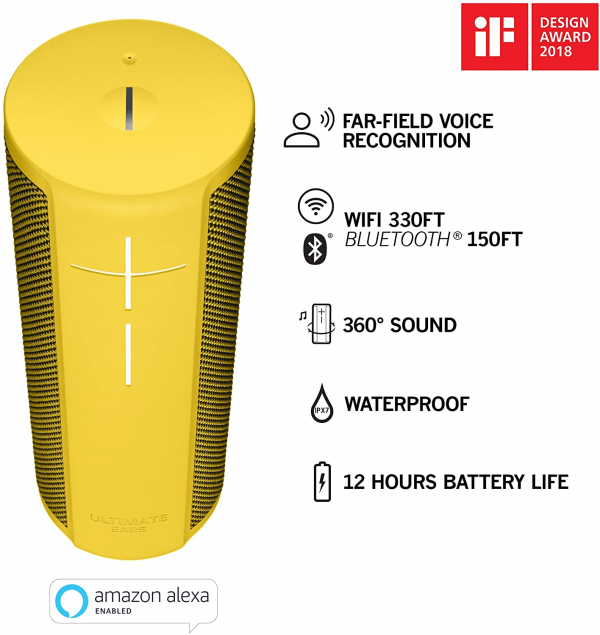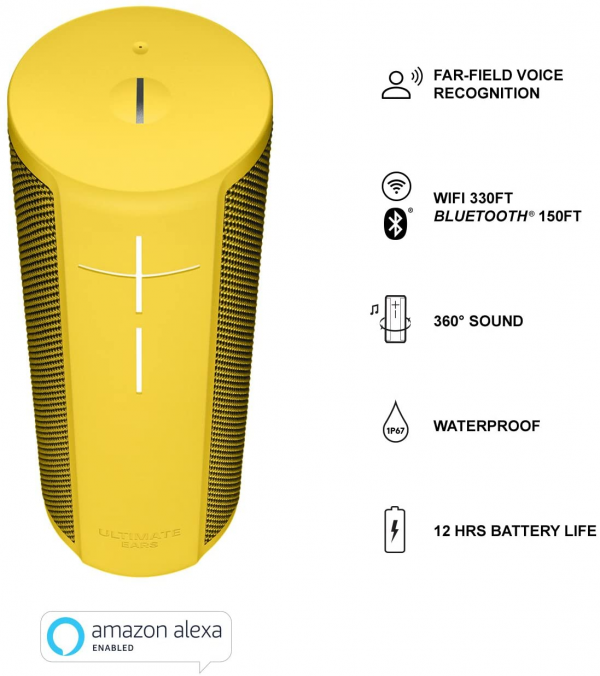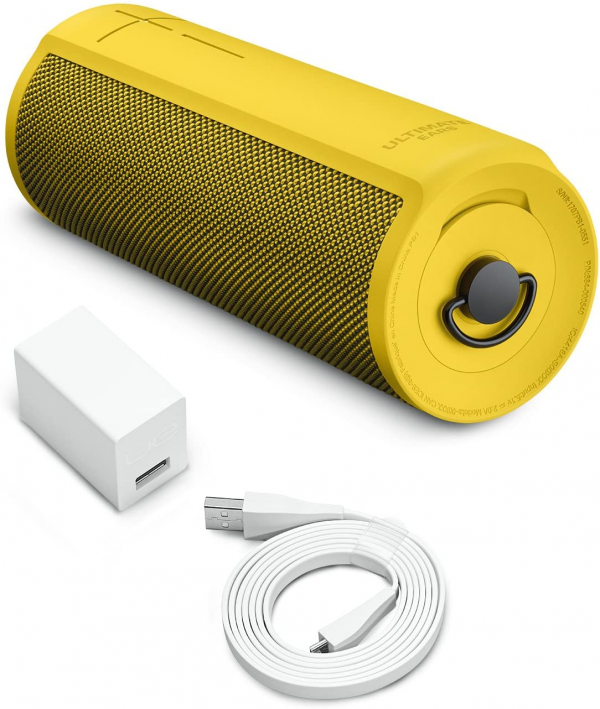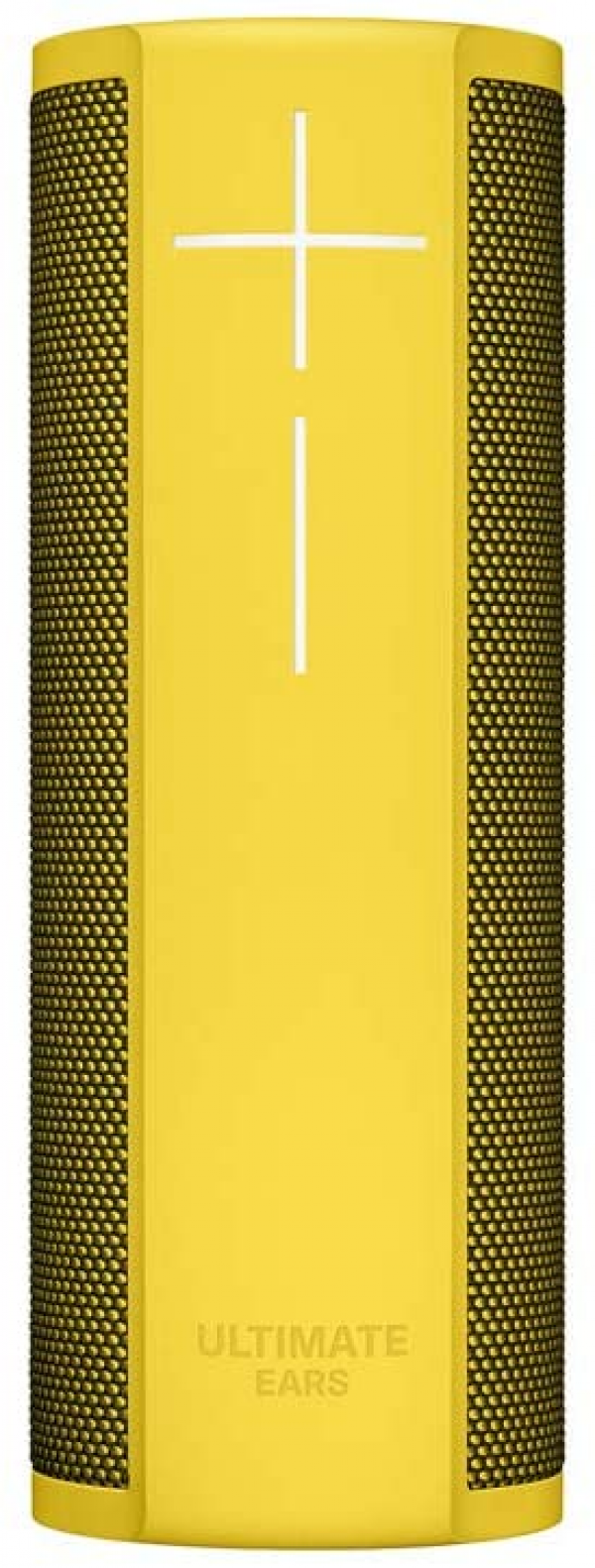Ultimate Ears
UE Blast: bestselling portable speaker awakens to Alexa
Aprox. 137€
See specificationsFor several years now, the success of the Boom range of Ultimate Ears portable speakers has not been denied. Here it is now available in a "smart" version, which takes the name Blast and adopts the Amazon Alexa voice assistant.
Positive points
Accuracy of restitution, distortion contained.
Excellent clarity of sound.
Good dynamics and good power handling.
Robust construction (IP67 certification).
Bad points
Promise of sound emission at 360 ° not kept, sound a little muffled from the front.
Very shy bass extension.
No wired connections.
Too few control buttons, no hands-free kit.
Noise sensitive speech recognition.
Our review
Ergonomics
Launched across the Atlantic in April 2018, the EU Blast (like its sister the Megablast) had to wait several months before landing on the French market - quite logically, since Amazon's voice assistant doesn't was then not available in Spain. Therefore, it should obviously not be surprising that the design and construction of the Blast take over that of the EU Boom 2, and not of the EU Boom 3, which was released last fall.
Less refined and less elegant than the latter, the Blast retains an efficient and robust manufacturing, with an IP67 certification. The manufacturer therefore guarantees the immunity of the machine against all types of solid particles and against immersion up to 1 meter deep. And if some people could criticize the rubbery plastic covering the enclosure for being somewhat messy, we can say that a simple passage under the tap is enough to get rid of fingerprints accumulated.
There is, however, a specificity that the Blast has in common with the Boom 3, which turns out to be an absence: that of any wired connection. Entry point mini-jack here, the Blast only knows the wireless communication (in Bluetooth or in Wi-Fi). This last connection gives access to Alexa and the Alexacast ecosystem, via which the speaker can natively access the streaming services Spotify, Deezer, TuneIn Radio, and of course Amazon Music. The speaker does not, however, offer any other connected functionality; do not therefore hope to be able to broadcast audio files stored on a UPnP / DLNA server or take advantage of any possibility of broadcasting in multiroom.
The UE Blast works in tandem with the mobile application of the same name, available on iOS and Android. In addition to its contribution to the initial configuration of the speaker and firmware updates, it also allows to combine several Blast and Megablast speakers in simultaneous broadcast, or two speakers in stereo.
More anecdotal, the application also gives access to a 5-band equalizer, the effects of which are unfortunately far too imprecise for them to have any relevance.
Regarding the physical control interfaces available on the speaker, the Blast is minimalist: there are two volume control buttons, an on / off button, an "action" button, and that's it. This sketch unfortunately forces certain commands to be grouped together on the same button (the action button is used to launch the Bluetooth pairing - long press - as well as to call Alexa manually - short press), to be associated with manipulations convoluted (press the Volume button and the action button simultaneously to open / close the Alexa microphone) ... or even to be simply absent (play / pause, navigation between tracks ...). Design issues have clearly taken precedence over practicality; it is sad.
The manufacturer promises 12 hours of battery life at its precincts; but during our measurement in mixed use with Bluetooth and Wi-Fi connected simultaneously, it was only able to stay awake for 8 hours. Without being impressive, this result remains correct for an enclosure of this type.
In Bluetooth, the broadcast latency is around 165 ms. This is a correct value. When it translates into a sound / image shift when watching a video, the desynchronization is very clearly perceptible, but just measured enough to get used to it after a few minutes - unless be very sensitive to the phenomenon.
Finally, it should be noted that like all smart speakers, for a reason that we do not know, the Blast does not have a hands-free kit function in Bluetooth.

Speech Recognition
When using Alexa, the UE Blast offers honest, yet far from flawless voice recognition. It certainly works well in a calm environment, the loudspeaker detecting calls made to it perfectly omnidirectionally, both in near and far fields - we have tested its operation up to a distance of 5 meters. However, we already note that the recognition of low voices is significantly less easy than that of high voices; a weakness common to all Alexa speakers, presumably entirely due to Amazon's speech processing algorithms.
Things get much more complicated when noise disturbances come into play, whether outside noise or the sound emitted by the speaker itself. As soon as you are in a slightly noisy environment, it is necessary to address the speaker with a voice significantly more powerful than the background noise to hope to be understood. In the context of a lively evening, for example, or when the speaker plays music at a volume above 60%, it becomes almost impossible to be heard in the far field.
The overall result is therefore not fundamentally bad for the EU Blast, but it remains fairly much lower than what is found in the neighbor. A JBL Link 20, for example, very comparable to the Blast but equipped with Google Assistant, offers much more reliable voice capture.

Audio
In a very predictable way, the UE Blast is as close to the Boom 2 in its sound performance as it is in its aesthetics.
Let's start by clarifying a first point: the promise made by Ultimate Ears of a sound deploying "360 °" is to be forgotten from the outset. Like all the manufacturer's cylindrical speakers, the Blast actually offers a guaranteed stereophonic reproduction by two wideband speakers positioned back to back, on the sides of the enclosure. With such a configuration, it is of course perfectly impossible to obtain a truly homogeneous diffusion in all directions.
And even if the speakers in question actually benefit from a rather weak directivity and a remarkably balanced absolute frequency response, the fact is that when we stand in front of the speaker, we inevitably perceives a sound with very attenuated treble, bordering on dullness. If this can become a real problem when used outdoors, the concern is generally, and fortunately, less pronounced indoors. We can then count on the natural reverberation of the listening room to redirect the high frequencies to the listener, and thus give the sound a completely honest clarity.
This clarity is further enhanced by the excellent precision that the Blast is capable of. The distortion is remarkably well contained and the accentuation of the treble extremes visible on the measurement of frequency response is thanks to this much less noticeable than what one might think. The sound never becomes acidic or aggressive. We can barely spot a slight tendency to shine when listening at high volume.
On the other side of the spectrum, on the other hand, the picture is worse. The extension of the bass produced by the Blast is very timid, not even going below 100 Hz. Portable speakers have accustomed us to better, especially for a product of this size. On the richest bass mixes, it is difficult not to feel frustrated by the very light basis of the sound.
However, to conclude on a positive note, note the very good dynamics produced by the Blast and its ability to assume without flinching the high sound levels. Obviously, the enclosure does not hesitate to use for this purpose a dynamic compression treatment, which starts from the level 60/100 approximately. Very discreet at first, this compression intensifies as you push the adjustment, and does not become really annoying until 85/100. At this level, we already have enough power to fill a small living room with sound, or even meet the musical needs of an evening out in small groups.

Conclusion
Ultimate Ears did not engage in any boldness in the design of its Blast, which, in addition to its integration of Alexa, has almost everything in common with the Boom 2 - except for the disappearance of the mini-jack input! It therefore remains an effective product, well constructed and with very correct performance, but which is only of interest to aficionados of Amazon's voice assistant. Others would do better to focus on the Boom 3, significantly superior to the Blast, especially in its restitution of low frequencies.

Specifications

